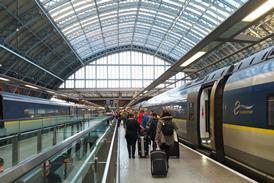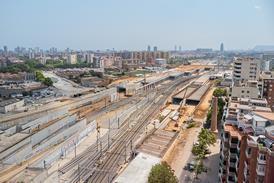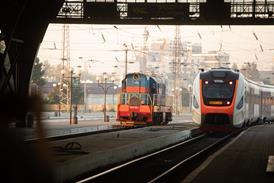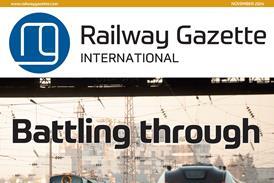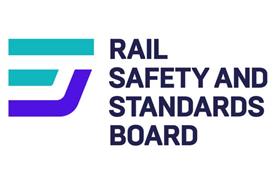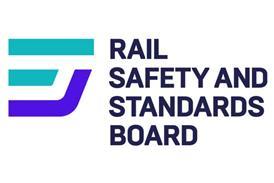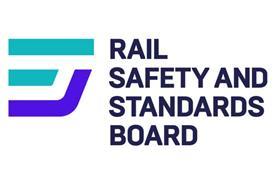INTRO: The first four-car Arlanda Express train is on trial in Sweden, and private-sector concessionaire A-Train is on schedule to launch services on the shuttle route next year. Andrew Hellawell toured the project site
ARRIVE in Stockholm by air, and the need for a rapid rail link from the main airport at Arlanda to the city centre is all too soon apparent. Buses and taxis are the only forms of public transport available, with journeys taking up to 1h 15min, depending on the weather and time of day. But this will change in the third-quarter of 1999, when a privately-funded rail link opens for business.
After six years of studies and tendering, the Arlanda Link Consortium was in 1995 awarded a 45-year concession to design, build, operate and maintain a 40 km express railway between the airport and the central station. The consortium includes Alstom, NCC (Sweden’s largest construction and civil engineering company), Vattenfall (Sweden’s major electricity supplier) and British civil engineering company John Mowlem.
To be known as Arlanda Express, the link will provide a fast, frequent and reliable service. Despite a number of delays in obtaining approvals, the project is on schedule, and marketing work is already in hand for next year’s launch. A major feature will be a guaranteed journey time of 20min, with a full refund should there be a delay; passengers with only hand luggage will be able to check-in at Stockholm Central. Another aim is to have through ticketing to make the journey as seamless as possible - a price of SKr100 for the single fare from Stockholm is being considered, as is the scope for luggage check-in at Stockholm.
The line has been built as a loop off Banverket’s main line from Stockholm to Uppsala, leaving it 10 km south of the airport near Rosersberg, then running under the airport in tunnel and rejoining the existing line north of Märsta. Banverket has laid a new fast track on each side of the existing pair from Stockholm Central to the flying junction for the new line, and SJ’s InterCity trains are already using these.
The line will have capacity for up to six Arlanda Expresses per hour each way, but the decision to build the line as a loop will allow Arlanda to be served by long distance InterCity trains from northern Sweden, so giving many more airline passengers direct access to their flights. Up to 12 InterCity services per hour in each direction could serve the airport. Additional trains could run to the airport, should a decision be taken to build the northern ’Crook’ curve, allowing SL’s local service to Märsta to be extended around the airport loop.
With this level of capacity, the link will be able to handle forecast traffic growth between Arlanda and Stockholm in years to come. At present 15 million passengers use the airport each year, and this is expected to rise to 21·5 million by 2005 - Arlanda Express should carry about 3·5 million passengers in its first full year, rising to 4·2 million by 2005. The link will initially open with four Arlanda Express trains an hour each way from 05.00 to midnight, with an hourly night train. InterCity trains will begin three months later.
Project structure and finance
During 1994, before the contract was let, the Swedish government formed the Arlanda Rights Company to grant the 45 year concession rights for the project to the successful consortium and to supervise arrangements for construction and operation of the link. It was the state-owned ARC which received the final tender submissions from the two prequalifiers for the work.
The ALC members formed a special-purpose company named A-Train, whose equity is owned by the members. A-Train’s task is to operate and maintain the railway during the life of the concession, with ALC providing the railway for A-Train to run as a design-and-build turnkey contract.
The financial arrangements for the project are complex and include equity from each of the consortium partners, government grant, government loans, private loans and leasing. Capital of SKr5bn was raised to ensure the expected SKr4·3bn construction cost would be covered. Although this structure was unique in Sweden, there has been close and valuable collaboration with the promoters of the London Heathrow and Oslo Gardermoen rail links.
Civil engineering
Banbrytarna, set up by NCC, is responsible for the civil works, which by mid-1998 were almost complete. They included building 14 km of double track formation at grade, constructing 9·2 km of tunnel (7 km for double track), building three underground stations, including escalator and lift accesses from the airport, and diverting or reconstructing existing roads and building new bridges and access roads.
Banbrytarna is also rebuilding tracks 1 and 2 at Stockholm Central station, which will be dedicated for Arlanda Express. Platform height is being raised to give level train boarding, and there will be better access from the rest of the station and the bus terminal above. A taxi rank is being constructed immediately adjacent to the platform.
At Arlanda the station complex comprises an extensive network of platform and running tunnels and connecting passages which will provide direct rail access from two Arlanda Express stops to the four main terminals, and from the through InterCity platform to the international terminal and SkyCity office and shopping complex. Around 820000m3 of rock was excavated from the tunnels, plus 400000m3 of soil. Much of the spoil was used in the foundations of the third runway and air cargo terminal now under construction.
Blasting the tunnels was extremely difficult as the area has varying ground conditions. Accuracy and a good knowledge of the ground conditions were therefore essential, and the work has now been successfully completed. Careful negotiations with the airport authorities were required for the blasting as the tunnels run directly under the airport. The same applied to the accesses and equipment locations on the airport concourses.
Mowlem, operating in Sweden as John Mowlem Construction, is responsible for laying 39 track-km, including 29 turnouts and crossovers. Pandrol’s Fastclip system has been used. By early July tracklaying was complete on the southern open-air section, and into the Arlanda Express platforms, with only the tunnel through the InterCity platforms to the north portal and the northern open-air section remaining to be done.
Completion of the permanent connection to the existing network is targetted for April 1999; after three months of trial running, commercial services are due to start in the third quarter of that year.
Power supply and trains
The power systems for the project are being installed by Banbrytarna. No new substations were required, and power is sourced from the Banverket network at 15 kV 16 2??3Hz. Emergency power is obtained from local authority supplies as required. Installation of catenary on the at-grade southern approach has been completed, with fitting out under way on the tunnel sections.
Alstom is supplying seven four-car electric multiple-units able to run at 200 km/h. Each set carries 190 seated passengers in a length of 93m; space is available for plenty of luggage estimated at 250 large suitcases. Matching platform height to train floor height will be of great benefit to passengers.
Alstom’s Onix IGBT equipment is fitted, and this same company furnished the auxiliary supply system. Bodyshells are fabricated in Barcelona and bogies in France. Regenerative, mechanical disc and track braking are provided with mechanical components from Knorr-Bremse. Schunk are supplying pantographs, and heating and air-conditioning equipment is from Hagenuk-Faiveley. Automatic train protection is fitted, and the driver has use of a train radio system, together with a Nordic Mobile Telephone. On-board passenger information on board from Alstom-EES will advise passengers about the journey time and the next station.
The first train was delivered on May 29 this year, and after getting approval from the Swedish rail safety authority, began trial running at up to 120 km/h on a 6 km test track near Västerås. Running tests at 200 km/h will take place on a 40 km section of the upgraded Mälarbanan under full possession, exploiting a programmed five-week line closure for engineering work at Kungsängen (p529). This should mean that the first set will be fully type-tested by the end of this year.
Trial runs over a defined route on the main line railway will verify operation of the ATP over an established signalling installation. From December testing with the new signalling and interlocking will take place. In January test running will get under way between the airport and Stockholm.
Further testing and mileage accumulation is due to continue until mid-1999, by which time Set 1 should have covered 40000 km. Deliveries of the other units are due to be monthly, with Set 2 due this month. Five trains are needed for the initial service start-up.
Signalling and communications
The signalling and train control chosen for the Arlanda Express is already widely used in Sweden. Supplied by Adtranz under subcontract to Alstom, it incorporates ATP using beacons as the communications link between train and track. Three interlocking computers control the Arlanda link with automatic line-block sections between each interlocking area.
The signalling is fully integrated with the surrounding railway network infrastructure and will be remotely controlled from the TCC building in Stockholm. In case of communication failure between Stockholm and Arlanda, local control will be available from a site close to the light maintenance depot near the airport.
Adtranz is also supplying train departure information and clocks for platform displays; the equipment is driven from the signalling at the traffic control centre in Stockholm.
The telecommunications system being supplied by Alcatel includes the following:

